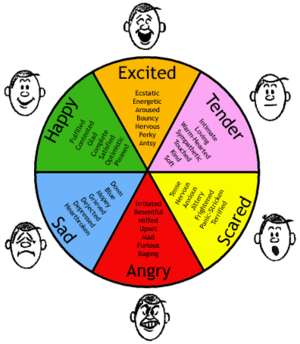Feeling facts for kids
Feeling is a word with a few different meanings, but they all have to do with how we sense the world around us and what goes on inside our bodies and minds. It can mean the sense of touch, like when you feel the softness of a blanket. It can also mean an emotion, like feeling happy or sad. Sometimes, it means a sensation, which is a physical feeling in your body, like feeling hungry or tired.
Contents
What is Feeling?
Feeling is how we experience things. It helps us understand our surroundings and what's happening inside us. Our bodies have special ways to pick up information, and our brains then interpret this information as different kinds of feelings. These feelings guide us and help us react to the world.
The Sense of Touch
One important meaning of feeling is the sense of touch. This is how we feel things with our skin. Our skin is covered with tiny nerve endings. These nerves send messages to our brain about what we are touching.
- How Touch Works: When you touch something, the nerve endings in your skin send signals up your spinal cord to your brain. Your brain then figures out what you are touching. It tells you if something is hot, cold, smooth, rough, soft, or hard.
- Different Types of Touch:
- Pressure: This is how we feel if something is pushing on us. For example, when you wear clothes, you feel the pressure of the fabric.
- Temperature: Our skin can tell if something is hot or cold. This helps us stay safe from extreme temperatures.
- Pain: Pain is a very important feeling. It tells us when something is hurting our body, like when you accidentally touch a hot stove. This warning helps us avoid more harm.
- Vibration: We can feel vibrations, like when a phone buzzes in your pocket.
- Texture: This is how we feel if something is smooth, bumpy, rough, or soft.
Feelings as Emotions
Another big part of feeling is our emotions. Emotions are strong feelings that come from our minds. They are how we react to different situations and events in our lives.
- What Are Emotions?: Emotions are complex reactions that involve our thoughts, bodies, and actions. They can be short-lived, like a sudden surprise, or last longer, like feeling happy for a whole day.
- Common Emotions: There are many different emotions. Some common ones include:
- Joy: Feeling happy, excited, or content.
- Sadness: Feeling unhappy, disappointed, or lonely.
- Anger: Feeling annoyed, frustrated, or mad.
- Fear: Feeling scared, anxious, or worried.
- Surprise: Feeling shocked or amazed by something unexpected.
- Disgust: Feeling a strong dislike for something.
- Why Do We Have Emotions?: Emotions help us understand ourselves and others. They also help us make decisions and react to challenges. For example, fear can help us avoid danger, and joy can encourage us to do things that make us feel good.
Feelings as Sensations
Sometimes, feeling refers to physical sensations inside our bodies that are not related to touch. These are signals our body sends to our brain about its internal state.
- Body Sensations: These are feelings like:
- Hunger: The feeling that your body needs food.
- Thirst: The feeling that your body needs water.
- Tiredness: The feeling that your body needs rest or sleep.
- Dizziness: The feeling of being unsteady or lightheaded.
- Nausea: The feeling of wanting to vomit.
- Internal vs. External Sensations: Touch is an external sensation because it comes from outside our body. Hunger or tiredness are internal sensations because they come from inside our body. Both are important for our well-being.
Images for kids
See also
 In Spanish: Sentimiento para niños
In Spanish: Sentimiento para niños



